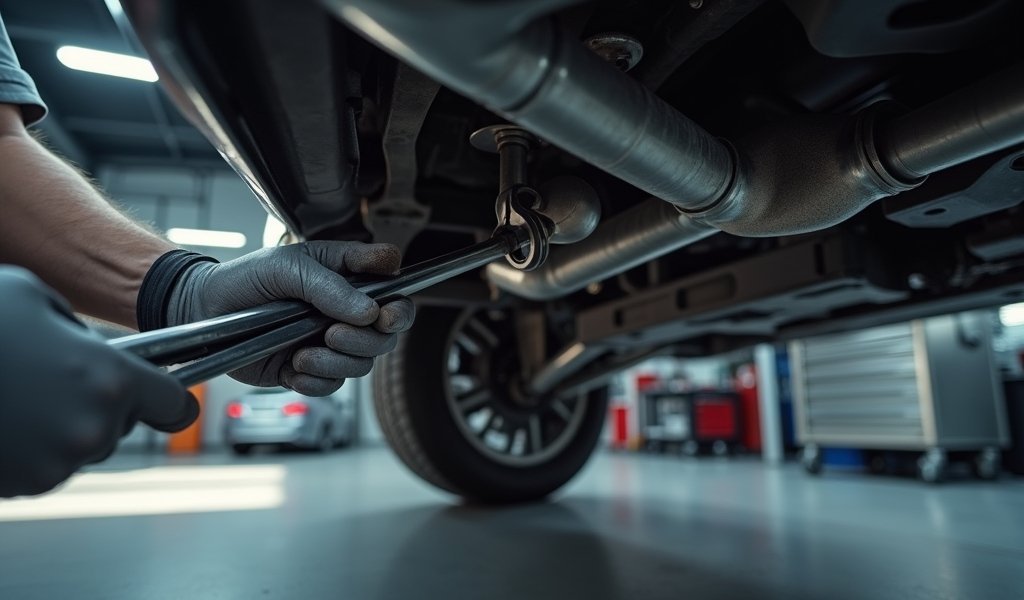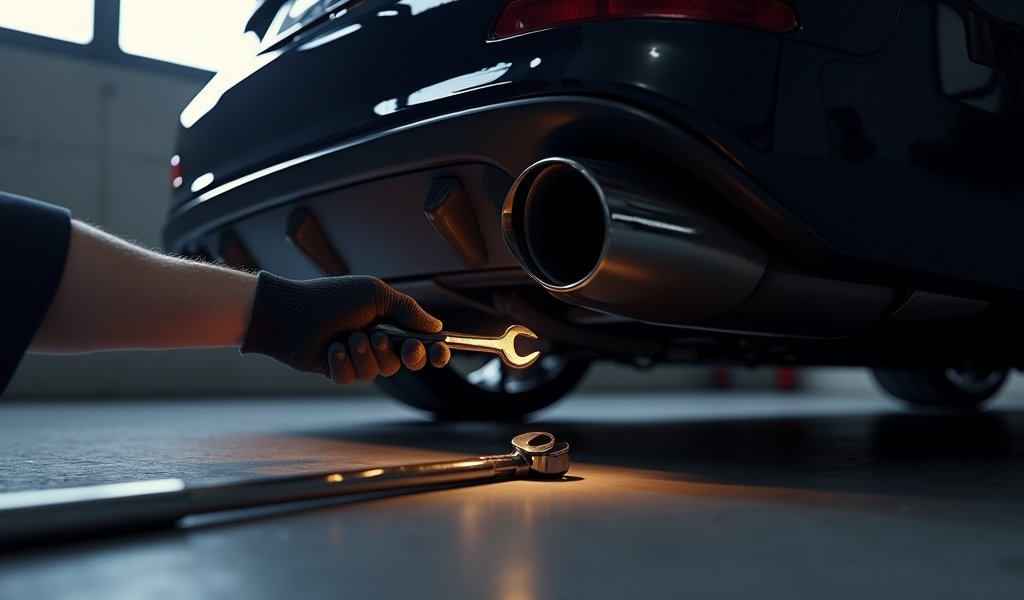Overview
This article provides a detailed guide to exhaust hanger replacement, covering identification of failing hangers, step-by-step replacement instructions, and preventative maintenance tips. It emphasizes that replacing exhaust hangers is an accessible DIY repair that prevents costly damage, eliminates annoying rattles, and maintains proper exhaust system function.
Table of Contents
- Understanding Exhaust Hangers: What They Are and Why They Matter
- Signs Your Exhaust Hangers Need Replacement
- Tools and Materials Needed for Replacement
- Step-by-Step Guide to Replacing Exhaust Hangers
- Preventative Maintenance Tips for Exhaust Hangers
- Choosing the Right Exhaust Hangers for Your Vehicle
- Common Mistakes to Avoid During Replacement
- Conclusion
- Frequently Asked Questions
Understanding Exhaust Hangers: What They Are and Why They Matter
Exhaust pipe hanger replacement might sound complicated, but it’s actually one of the more straightforward repairs you can tackle yourself. As a mechanic who’s spent years underneath vehicles, I can tell you that these small rubber components play a crucial role in your exhaust system’s health and your vehicle’s overall performance.
So what exactly are exhaust hangers? They’re the rubber components that suspend your exhaust system beneath your vehicle. Think of them as the unsung heroes of your undercarriage – they absorb vibrations, prevent metal-on-metal contact, and keep your exhaust pipes from dragging on the road. Without properly functioning hangers, you’ll not only hear annoying rattles and clanks, but you could also face more serious damage to your exhaust gas recirculation system and other components.
These hangers are typically made of durable rubber that can withstand heat and environmental factors, but they’re not immortal. Over time, they deteriorate due to constant exposure to heat cycles, road salt, and environmental elements. Most vehicles use several hangers strategically placed along the exhaust system, from the manifold all the way back to the tailpipe.
Signs Your Exhaust Hangers Need Replacement
How do you know when it’s time for an exhaust pipe hanger replacement? Your car will usually let you know, though the signs might be subtle at first. The most obvious indication is an exhaust pipe that’s hanging noticeably lower than normal. If you’ve ever seen a car with its exhaust nearly scraping the ground, you’re witnessing failed hangers in action.
But before things get that dramatic, you’ll likely notice some earlier warning signs:
- Unusual rattling or metallic clunking, especially when going over bumps
- Increased exhaust noise or a change in the exhaust note
- Visible sagging of any part of the exhaust system
- Rubber hangers that look cracked, stretched, or broken during visual inspection
- Exhaust pipes touching or nearly touching other components under the vehicle
If you hear a distinct metallic clank when starting your car on a cold morning, that’s often the sound of an unsupported exhaust system expanding and moving around. This is particularly true with custom exhaust systems that might be heavier than stock configurations.
When I’m examining a vehicle with suspected hanger issues, I always look for signs of uneven wear or heat discoloration around mounting points. These can indicate that the system has been moving excessively and needs attention before more serious problems develop.

Tools and Materials Needed for Replacement
One of the best things about exhaust pipe hanger replacement is that it requires minimal tools and materials. You don’t need a fully stocked professional garage to handle this job effectively. Here’s what you’ll need to gather before getting started:
Essential Tools:
- Jack and jack stands (safety first!)
- Penetrating oil (WD-40 or similar)
- Pliers or hanger removal tool
- Wire brush for cleaning mounting points
- Safety glasses and work gloves
- Flashlight or work light
Materials:
- Replacement rubber exhaust hangers (vehicle-specific or universal)
- High-temperature silicone lubricant
- Anti-seize compound (for metal components)
When selecting replacement hangers, you have options. OEM (Original Equipment Manufacturer) parts will be the exact match for your vehicle but might cost more. Aftermarket universal hangers are more affordable and work well in most cases. According to Motor Trend’s maintenance guide, using slightly heavier-duty hangers than stock can actually improve durability in harsh climates.
I always recommend having a few extra hangers on hand. They’re inexpensive, and you might discover additional worn hangers once you start inspecting the entire system. Plus, having spares means you won’t need to halt your project midway if you accidentally damage one during installation.
Step-by-Step Guide to Replacing Exhaust Hangers
Now let’s get down to business with a detailed, step-by-step guide to exhaust pipe hanger replacement. I’ve broken this down into manageable steps that anyone with basic mechanical skills can follow:
1. Preparation and Safety First
Park your vehicle on a flat, level surface and allow the exhaust system to cool completely. I can’t stress this enough – exhaust components get extremely hot and can cause serious burns. If you’ve been driving, give it at least an hour to cool down. Apply the parking brake and chock the wheels for additional safety.
2. Raise the Vehicle
Using your jack, lift the vehicle and secure it properly on jack stands. Never work under a vehicle supported only by a jack! Position the stands at the manufacturer’s recommended jacking points, usually indicated in your owner’s manual. Make sure the vehicle is stable before proceeding.
3. Locate and Inspect the Hangers
With good lighting, locate all the exhaust hangers. Most vehicles have 4-6 hangers distributed from the front to the rear of the exhaust system. Carefully inspect each one, noting which need replacement. Sometimes what looks like a hanger issue could be a broken mounting bracket, so check thoroughly.
4. Remove the Old Hangers
This is where a bit of technique comes in handy. Spray each hanger connection with penetrating oil and let it sit for a few minutes. Using pliers or a specialized hanger removal tool, grasp the rubber hanger firmly and pull/twist it off the metal rods. A twisting motion often works better than pulling straight out. If the hanger is severely deteriorated, it might come apart during removal – that’s normal.
5. Clean the Mounting Points
Use a wire brush to clean any rust or debris from the metal mounting points. This ensures the new hangers will seat properly and last longer. If you notice excessive rust or damage to the mounting brackets themselves, this might require additional repairs.
6. Install New Hangers
Apply a small amount of silicone lubricant to the inside of the new rubber hangers – this makes installation much easier. Position the hanger on one mounting point first, then stretch it slightly to connect to the other point. The rubber should be snug but not excessively stretched or twisted.
7. Verify Proper Positioning
Once installed, check that the exhaust system is hanging at the proper height and isn’t touching any other components. The system should have some movement but shouldn’t sag noticeably. As mentioned by Car and Driver’s repair experts, proper alignment prevents heat transfer to other components and reduces noise.
8. Lower the Vehicle and Test
Carefully lower your vehicle, remove the jack stands, and start the engine. Listen for any unusual rattles or vibrations. A properly hung exhaust system should be relatively quiet at idle. Take the vehicle for a short test drive, paying attention to how it sounds over bumps and at different speeds.
Preventative Maintenance Tips for Exhaust Hangers
An ounce of prevention is worth a pound of cure, especially when it comes to your exhaust system. Including hanger inspection in your regular maintenance routine can save you from more costly repairs down the road. Here are my tried-and-true preventative maintenance tips:
- Inspect hangers visually at least twice a year, especially before and after winter in areas where road salt is used
- Spray rubber hangers with a silicone-based protectant during oil changes to prolong their life
- Listen for changes in exhaust sound that might indicate developing hanger issues
- Replace hangers at the first sign of deterioration – don’t wait until they’ve completely failed
- Consider upgrading to higher-quality aftermarket hangers if you frequently drive on rough roads
One trick I’ve learned over the years is to gently push up on your exhaust pipe (when cool!) while the engine is running at idle. If you hear a change in the exhaust note or feel excessive movement, that’s a clear indication that your hangers need attention. This simple test takes seconds but can reveal developing problems.
The way you drive can also impact hanger life. Frequent high-speed driving over rough roads or off-road conditions puts additional stress on your exhaust system. If your driving habits are particularly demanding, consider checking your aftermarket exhaust hangers more frequently.

Choosing the Right Exhaust Hangers for Your Vehicle
Not all exhaust hangers are created equal, and selecting the right ones for your specific vehicle and driving conditions can make a big difference in performance and longevity. Here’s what to consider when shopping for replacement hangers:
Material Quality
Standard rubber hangers work well for most applications, but if you live in an area with extreme temperatures or drive a performance vehicle, consider upgrading to high-temperature silicone hangers. They cost more but can last significantly longer in challenging conditions. According to research from the Society of Automotive Engineers, silicone hangers can withstand temperatures up to 100°F higher than standard rubber versions.
Fitment Options
You’ll typically have three options for exhaust hanger replacement:
- OEM Hangers: Direct replacements from your vehicle manufacturer – perfect fit but highest cost
- Direct-fit Aftermarket: Designed for specific vehicle makes/models at a lower price point
- Universal Hangers: The most affordable option that can work on multiple vehicles
For most DIY repairs, direct-fit aftermarket hangers offer the best balance of cost and convenience. They’re designed to match the dimensions and mounting points of your specific vehicle without the premium price of OEM parts.
Performance Considerations
If you’ve modified your exhaust system or are looking for different performance characteristics, you might consider hangers with varying stiffness:
- Softer hangers: Provide more vibration isolation and a quieter ride
- Stiffer hangers: Reduce exhaust movement and can improve performance in some applications
- Polyurethane hangers: Offer a middle ground with better durability than rubber but more flexibility than solid mounts
For most daily drivers, standard or slightly upgraded rubber hangers are the sweet spot. They provide good vibration damping while still being durable and affordable. I typically recommend sticking close to the OEM stiffness unless you have specific performance goals in mind.
Common Mistakes to Avoid During Replacement
Even a relatively simple job like exhaust pipe hanger replacement has its pitfalls. After seeing hundreds of DIY attempts gone wrong, I can help you avoid the most common mistakes:
Using the Wrong Size or Type
This might seem obvious, but using hangers that are too large or too small for your mounting points can lead to premature failure or inadequate support. Always match new hangers to your original parts or consult a parts catalog for the correct specifications.
Inadequate Lubrication
Trying to install rubber hangers without lubricant is like trying to put on wet jeans – unnecessarily difficult and potentially damaging. A small amount of silicone lubricant makes installation much easier and prevents tearing the rubber during installation.
Ignoring Related Components
While replacing hangers, take the opportunity to inspect the entire exhaust system, including pipes, connections, and catalytic converters. Sometimes what appears to be a hanger issue is actually a symptom of other exhaust problems like a broken flange or loose connection.
Improper Installation Sequence
Always work from front to back when replacing multiple hangers. The exhaust system’s weight distribution changes as you remove and replace hangers, so maintaining proper support throughout the process prevents undue stress on remaining components.
Forgetting the Test Drive
Many DIYers skip the crucial test drive after installation. This final check helps ensure there are no rattles, vibrations, or clearance issues that might only become apparent when the vehicle is in motion. A quick drive around the block at various speeds can reveal problems that aren’t noticeable when stationary.
Conclusion
Exhaust pipe hanger replacement is one of those rare automotive repairs that delivers significant benefits without requiring advanced mechanical skills or expensive tools. By understanding the importance of these humble rubber components and following the steps outlined in this guide, you can restore proper support to your exhaust system, eliminate annoying rattles, and prevent more costly damage down the road.
Remember that maintaining your exhaust hangers is part of overall vehicle care. Regular inspections and prompt replacement when needed will keep your exhaust system properly supported and functioning optimally. Whether you drive a daily commuter or a weekend performance machine, giving attention to these often-overlooked components pays dividends in vehicle longevity and driving enjoyment.
So the next time you notice a sagging exhaust or hear that distinctive rattle over bumps, don’t ignore it – grab your tools and tackle this simple fix yourself. Your car (and your wallet) will thank you for it!
Frequently Asked Questions
How long does it take to replace exhaust hangers?
For most vehicles, expect to spend 30-60 minutes replacing all hangers. The exact time depends on your experience level and how accessible the hangers are on your specific vehicle model.
How much do replacement exhaust hangers cost?
OEM exhaust hangers typically cost $10-30 each, while aftermarket options range from $3-15 per hanger. Most vehicles have 4-6 hangers total.
Can I drive with a broken exhaust hanger?
It’s not recommended to drive with broken exhaust hangers as this can cause damage to other exhaust components and create unsafe conditions. The unsupported exhaust could contact other components or the road surface.
How often should exhaust hangers be replaced?
There’s no set replacement interval, but inspect them annually and replace as needed. Most quality hangers last 5-7 years under normal driving conditions.
Can I use universal exhaust hangers on any vehicle?
Universal hangers work on many vehicles but may not provide the ideal fit for all applications. For best results, use hangers designed specifically for your vehicle make and model.

